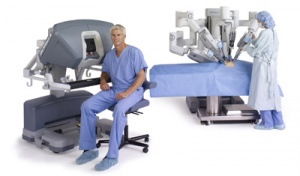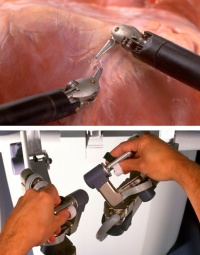Da Vinci Surgical System
Da Vinci Surgical System is a minimally invasive surgery performed with robotic assistance. The Da Vinci was created by Intuitive Surgical and is currently the only approved robotic surgical system approved by the Food and Drug Administration. The Da Vinci has been famed for its increased precision and enhanced range of motion in comparison to open surgery. Within the last 14 years, 1.75 million of these robotic procedures have been performed in the United States. [1]:
Contents
System Overview
System Components
The system consists of two separate consoles the surgeon's console and the robotic console. The surgeon's console is where the surgeon sits and is provided with high quality 3D visual feedback. He or she is able to control the separate robotic console with the use of hand manipulators and foot pedals. The separate robotic console consists of three to four robotic arms. One arm holds a laparoscopic camera that provides the visual feedback to the surgeon console, and the other three arms are used to hold surgical instruments. Attached to two robotics arms are the EndoWrist instuments which provide 7 df similar to the human hand. [2] The movements of the surgeons hands are translated into the computer which then moves these wrist instruments. This movement is scaled up by ten folds. This scale change allows for the increased precision.
Training
The Da Vinci system requires extensive training. Intuitive Surgical teams up with each hospital to run surgeons through four phases of training :[3]
- Phase 1: Introduction to da Vinci (Product Training)
- Phase 2: da Vinci Technology Training (Product Training)
- Phase 3: Initial Case Series Plan(Skills Application)
- Phase 4: COntinuing Development (Skills Application)
Each hospital varies in how each candidate is given credentials or privileges.
Procedures
Types of surgeries completed with the Da Vinci[4]
- Cardiac Surgery
- Colorectal Surgery
- General Surgery
- Gynecologic Surgery
- Head & Neck Surgery
- Thoracic Surgery
- Urologic Surgery
Costs
The average machine unit cost is $1 to $2.5 million. On a procedural basis, the da Vinci surgery is an additional $1,600 than the general procedure without robotic assistance, this is about a 6% increase. [5]: Most insurance companies do not reimburse more money for these robotic assisted procedures then they would for the general procedure.
Patient Risk
References
- ↑ Alemzadeh, Homa et al. “Adverse Events in Robotic Surgery: A Retrospective Study of 14 Years of FDA Data.” Ed. Hyun-Sung Lee. PLoS ONE 11.4 (2016): e0151470. PMC. Web. 20 Feb. 2017.
- ↑ Schreuder, H. and Verheijen, R. (2009), Robotic surgery. BJOG: An International Journal of Obstetrics & Gynaecology, 116: 198–213. doi:10.1111/j.1471-0528.2008.02038.x
- ↑ "Da Vinci® Training." Intuitive Surgical - Training. N.p., n.d. Web. 19 Feb. 2017.
- ↑ "The Da Vinci® Surgical System." Da Vinci Surgery - Minimally Invasive Robotic Surgery with the Da Vinci Surgical System. N.p., n.d. Web.
- ↑ Barbash, Gabriel I., M.D., and Sherry A. Glied, PhD. "New Technology and Health Care Costs - The Case of Robot-Assisted Surgery — NEJM." New England Journal of Medicine. The New England Journal of Medicine, n.d. Web.

